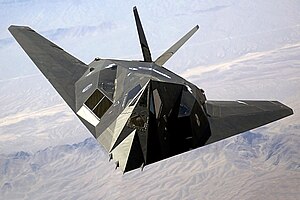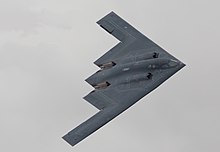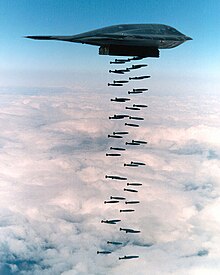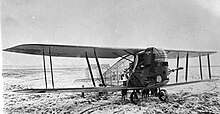
The Northrop Grumman B-2 Spirit, also known as the Stealth Bomber, is an American heavy strategic bomber, featuring low-observable stealth technology designed to penetrate dense anti-aircraft defenses. A subsonic flying wing with a crew of two, the plane was designed by Northrop and produced from 1987 to 2000. The bomber can drop conventional and thermonuclear weapons, such as up to eighty 500-pound class (230 kg) Mk 82 JDAM GPS-guided bombs, or sixteen 2,400-pound (1,100 kg) B83 nuclear bombs. The B-2 is the only acknowledged in-service aircraft that can carry large air-to-surface standoff weapons in a stealth configuration.

Fighter aircraft are military aircraft designed primarily for air-to-air combat. In military conflict, the role of fighter aircraft is to establish air superiority of the battlespace. Domination of the airspace above a battlefield permits bombers and attack aircraft to engage in tactical and strategic bombing of enemy targets.

The Lockheed F-117 Nighthawk is a retired American single-seat, subsonic twin-engine stealth attack aircraft developed by Lockheed's secretive Skunk Works division and operated by the United States Air Force (USAF). It was the first operational aircraft to be designed with stealth technology.

The Lockheed Martin/Boeing F-22 Raptor is an American single-seat, twin-engine, supersonic all-weather stealth fighter aircraft developed for the United States Air Force (USAF). As a product of the USAF's Advanced Tactical Fighter (ATF) program the aircraft was designed as an air superiority fighter, but also incorporates ground attack, electronic warfare, and signals intelligence capabilities. The prime contractor, Lockheed Martin, built most of the F-22's airframe and weapons systems and conducted final assembly, while program partner Boeing provided the wings, aft fuselage, avionics integration, and training systems.

Stealth technology, also termed low observable technology, is a sub-discipline of military tactics and passive and active electronic countermeasures, which covers a range of methods used to make personnel, aircraft, ships, submarines, missiles, satellites, and ground vehicles less visible to radar, infrared, sonar and other detection methods. It corresponds to military camouflage for these parts of the electromagnetic spectrum.
Supercruise is sustained supersonic flight of a supersonic aircraft without using afterburner. Many supersonic military aircraft are not capable of supercruise and can maintain Mach 1+ flight only in short bursts with afterburners. Aircraft such as the SR-71 Blackbird are designed to cruise at supersonic speed with afterburners enabled.

The fourth-generation fighter is a class of jet fighters in service from around 1980 to the present, and represents design concepts of the 1970s. Fourth-generation designs are heavily influenced by lessons learned from the previous generation of combat aircraft. Third-generation fighters were often designed primarily as interceptors, being built around speed and air-to-air missiles. While exceptionally fast in a straight line, many third-generation fighters severely lacked in maneuverability, as doctrine held that traditional dogfighting would be impossible at supersonic speeds. In practice, air-to-air missiles of the time, despite being responsible for the vast majority of air-to-air victories, were relatively unreliable, and combat would quickly become subsonic and close-range. This would leave third-generation fighters vulnerable and ill-equipped, renewing an interest in manoeuvrability for the fourth generation of fighters. Meanwhile, the growing costs of military aircraft in general and the demonstrated success of aircraft such as the McDonnell Douglas F-4 Phantom II gave rise to the popularity of multirole combat aircraft in parallel with the advances marking the so-called fourth generation.

The Northrop/McDonnell Douglas YF-23 is an American single-seat, twin-engine, supersonic stealth fighter aircraft technology demonstrator designed for the United States Air Force (USAF). The design was a finalist in the USAF's Advanced Tactical Fighter (ATF) competition, battling the Lockheed YF-22 for a production contract. Two YF-23 prototypes were built.

Lockheed Have Blue was the code name for Lockheed's proof of concept demonstrator for a stealth fighter. Have Blue was designed by Lockheed's Skunk Works division, and tested at Groom Lake, Nevada. The Have Blue was the first fixed-wing aircraft whose external shape was defined by radar engineering rather than by aerospace engineering. The aircraft's faceted shape was designed to deflect electromagnetic waves in directions other than that of the originating radar emitter, greatly reducing its radar cross-section.

An infrared search and track (IRST) system is a method for detecting and tracking objects which give off infrared radiation, such as the infrared signatures of jet aircraft and helicopters.

The Sukhoi Su-57 is a twin-engine stealth multirole fighter aircraft developed by Sukhoi. It is the product of the PAK FA programme, which was initiated in 1999 as a more modern and affordable alternative to the MFI.
Replica was a design study for an envisioned military aircraft with stealth capabilities, developed by British defence manufacturer BAE Systems. It was ultimately not pursued as the British government chose to proceed with involvement in the American Joint Strike Fighter programme instead, which ultimately led to the Lockheed Martin F-35 Lightning II.
The Lockheed Senior Prom was a classified black project conducted by the United States Air Force in conjunction with the Lockheed Corporation's Skunk Works for the development and testing of a cruise missile using stealth technology. Based on the company's Have Blue demonstrator, the six Senior Prom vehicles proved successful in testing conducted at Area 51 in the late 1970s; despite this, the aircraft was not selected to enter production, and the program was terminated in the early 1980s.
Infrared signature, as used by defense scientists and the military, is the appearance of objects to infrared sensors. An infrared signature depends on many factors, including the shape and size of the object, temperature, and emissivity, reflection of external sources from the object's surface, the background against which it is viewed and the waveband of the detecting sensor. As such there is no all-encompassing definition of infrared signature nor any trivial means of measuring it. For example, the infrared signature of a truck viewed against a field will vary significantly with changing weather, time of day and engine loading.
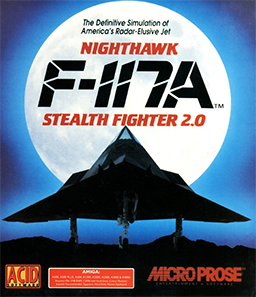
F-117A Nighthawk Stealth Fighter 2.0 is the 1991 remake of the 1988-1990 Cold War combat flight simulator video game F-19 Stealth Fighter by MicroProse, itself a remake of the 1987's Project Stealth Fighter. The original PC version was updated with a corrected aircraft model once the Lockheed F-117 Nighthawk was declassified and with 256-color VGA graphics instead of the original's 16-color EGA, among other changes.

The MBB Lampyridae was a low-observable medium missile fighter (MRMF) developed during the 1980s by the West German aerospace company Messerschmitt-Bölkow-Blohm (MBB). The programme was terminated during 1987 without any production aircraft having been produced.

A fifth-generation fighter is a jet fighter aircraft classification which includes major technologies developed during the first part of the 21st century. As of 2024, these are the most advanced fighters in operation. The characteristics of a fifth-generation fighter are not universally agreed upon, and not every fifth-generation type necessarily has them all; however, they typically include stealth, low-probability-of-intercept radar (LPIR), agile airframes with supercruise performance, advanced avionics features, and highly integrated computer systems capable of networking with other elements within the battlespace for situational awareness and C3 (command, control and communications) capabilities.

Aircraft camouflage is the use of camouflage on military aircraft to make them more difficult to see, whether on the ground or in the air. Given the possible backgrounds and lighting conditions, no single scheme works in every situation. A common approach has been a form of countershading, the aircraft being painted in a disruptive pattern of ground colours such as green and brown above, sky colours below. For faster and higher-flying aircraft, sky colours have sometimes been used all over, while helicopters and fixed-wing aircraft used close to the ground are often painted entirely in ground camouflage. Aircraft flying by night have often been painted black, but this actually made them appear darker than the night sky, leading to paler night camouflage schemes. There are trade-offs between camouflage and aircraft recognition markings, and between camouflage and weight. Accordingly, visible light camouflage has been dispensed with when air superiority was not threatened or when no significant aerial opposition was anticipated.

On 27 March 1999, during the NATO bombing of Yugoslavia, a Yugoslav Army unit shot down an F-117 Nighthawk stealth aircraft of the United States Air Force by firing a S-125 Neva/Pechora surface-to-air missile. It was the first ever shootdown of a stealth technology airplane. The pilot ejected safely and was rescued by U.S. Air Force Pararescuemen conducting search and rescue.
Cooperative Engagement Capability (CEC) is a sensor network with integrated fire control capability that is intended to significantly improve battle force air and missile defense capabilities by combining data from multiple battle force air search sensors on CEC-equipped units into a single, real-time, composite track picture. This will greatly enhance fleet air defense by making jamming more difficult and allocating defensive missiles on a battle group basis.
